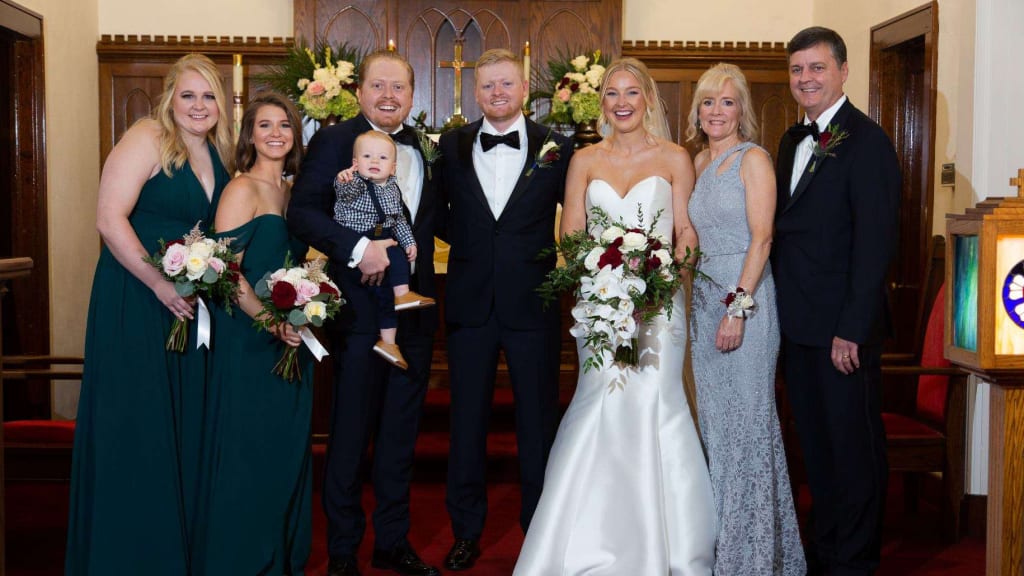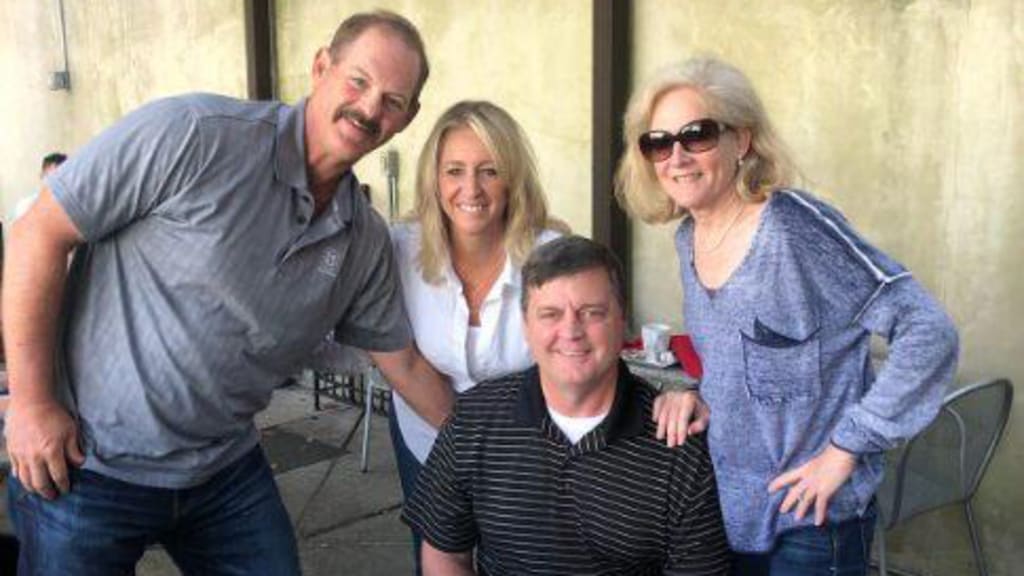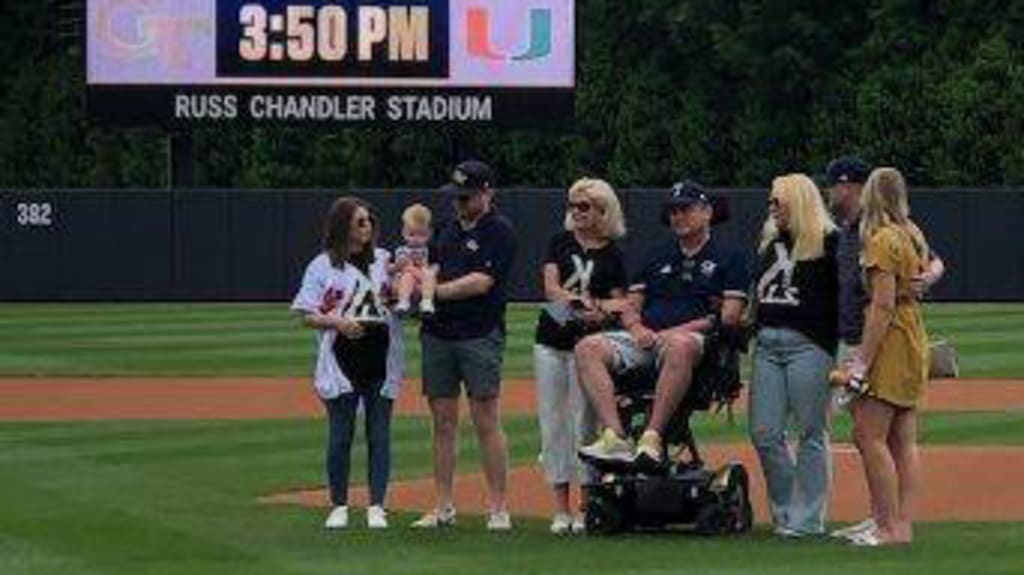
When baseball fans salute former Major League reliever Jim Poole during a pregame Lou Gehrig Day presentation at Camden Yards on Thursday, they’ll see him restricted to his wheelchair as his son, Hayden, throws out a ceremonial first pitch on his behalf. They’ll see the physical toll that amyotrophic lateral sclerosis, or ALS, has taken on Jim’s body.
What they won’t see is the emotional and financial toll this terrible illness has taken on Jim and his wife, Kim, in the one year since Jim’s diagnosis.
As if being afflicted with a fatal disease -- one with a typical survival time of just two to five years -- is not devastating enough, ALS patients and their families also encounter a nebulous network of medical paperwork, insurance issues, loaner equipment and delays in a situation where every second counts. The stress of the diagnosis is compounded by the stress of an often unsympathetic system in which good help is hard to find.
“It’s beg, steal or borrow,” Kim says.
Jim’s trip to Baltimore is evidence of the difficulty of navigating ALS.
It took four long months after his legs stopped functioning properly for Jim to get insurance to cover that motored wheelchair he’ll ride on the field.
In the midst of a pandemic-era vehicle shortage, it was similarly difficult to obtain the wheelchair-accessible van used to transport Jim from his home outside Atlanta to Baltimore. (A new version costs $80,000, but the Pooles were fortunate to find a used one from another ALS patient.)
As of this writing, the Pooles were planning to make the 700-mile drive straight, because moving Jim’s medical equipment in and out of a hotel room for one night along the way was not feasible. They also made plans to borrow a Hoyer lift -- a device that those with mobility issues use to get in and out of the bed and bath -- for the trip from another family of an ALS patient, because their insurance company had not yet provided one.
With Jim having recently lost much of his ability to speak, the Pooles had hoped to get him a device that allows people with disabilities to type messages on a screen via their eye gazes. But that request has so far been denied by their provider -- because Jim still has one functioning arm.
“You pay all this money into an insurance company your entire life and are never sick,” Kim says. “Then something like this happens and the medical companies can’t make money on a drug or the volume of equipment, so you’re on your own.”
Jim is 56 years old. He spent 11 seasons in the big leagues with eight teams, predominantly the Indians, Orioles and Giants. He managed his money well. So well that, in recent years, he has worked as a wealth management advisor to other professional ballplayers. He and Kim have three grown children (sons Hayden and Austin and daughter Courtney) and became grandparents to a boy named Montgomery in 2020. They have a granddaughter on the way in the next few weeks. As they neared retirement, they wanted to babysit and travel and enjoy the fruits of their labor.

ALS hit them like a freight train.
“We became empty nesters and had all these plans and things we were going to do,” Kim says. “All of a sudden, yeah … we’re going to do something else.”
Jim had experienced weakness in his left arm for several months. He figured it was the effect of 363 relief innings in the big leagues and assumed he might need elbow surgery. But his left leg was also giving him problems, and appointments with a sequence of specialists made it increasingly clear that something more sinister was going on inside his body.
When MLB held its first annual Lou Gehrig Day on June 2 last year, Jim had not yet been officially diagnosed. But by then, he and Kim had done their research.
“We didn’t say it to each other,” Kim says. “But we looked at each other, watching that first Lou Gehrig Day game, and we had it in our gut what it was.”

Jim was diagnosed by Dr. Jonathan Glass of the Emory ALS Center in Atlanta on June 15, 2021. He is believed to be just the third person who had a significant MLB career to be diagnosed with ALS, along with Hall of Famers Gehrig and Jim “Catfish” Hunter.
Not long after the diagnosis, Kim dug up one of Jim’s old baseball cards depicting him in his rookie year with the Dodgers. The Topps card highlighted the date of his Major League debut:
June 15, 1990. Thirty-one years to the day before he was given the awful news.
When you’re called up to the big leagues, you enter a world in which so much is at your disposal. Flights and hotels are booked on your behalf. Team trainers and doctors cater to your every ache and ailment. Meals are assembled by clubhouse cooks.
Getting the call that you have ALS is completely different. The diagnosis is as grim as it gets, and treatments and therapies are still in development.
“The Emory ALS Clinic has no funding, it’s understaffed,” Kim says. “They can’t provide anything to us besides maybe a prescription.”
The Pooles have found help through charitable organizations such as the ALS Association, Team Gleason and I AM ALS. They’ve connected with other families through Facebook and found a supportive community that dispatches advice, used equipment and moral support to those who need it.
“It’s a small club,” Kim says, “but it’s tight.”

But while the assistance of the ALS community is invaluable, ultimately it falls on the caregiver to assist the afflicted as ALS runs its course and debilitates the body.
Kim left her career as a market representative at a moving company for the elderly in order to look after her husband full-time. Even as he has lost function of his legs and one of his arms and now struggles to speak, Jim continues to report to his office a couple of days each week and visit with athletes he hopes to advise. So Kim drives him around in that van. She gives him his meals and medications. She bathes him and dresses him.
Because professional in-home help is scarce -- especially in an economy with a caregiver shortage -- Kim’s caregiving is a 24/7/365 job. She does it with love, but the pain in her voice from the couple’s dashed dreams is evident.
“I still want to be a mom and a grandmom and a sister and other things,” she says. “All my other roles pretty much get taken away.”
Kim’s role will only become more difficult in the coming months, as Jim loses more function.
“[ALS] comes in different stages,” she says. “When you move into another stage, it’s difficult. Then you hit a plateau for a while. You know that each day is as good as it’s going to get, so you try to make the most of every day.”
Jim and Kim met at freshman orientation, when they were both engineering students and athletes at Georgia Tech. She played soccer; he, of course, played baseball. A Major League life was the furthest thing from their mind at that point. Jim’s academic scholarship was larger than his athletic scholarship, and it’s Kim’s hunch that he was brought on the baseball team in order to bring up its collective GPA.

But Jim’s inquisitive and numbers-oriented mind served him well in sizing up opposing hitters … and being left-handed helped, too. Jim’s long Major League career brought him and Kim a beautiful life.
That life was upended by ALS. Since his diagnosis, people have told Jim he should have a “bucket list” of things he wants to do and see before he dies. But he can’t golf like he used to. He can’t travel like he used to. The plans he and his wife made for their retirement years are gone.
So Jim and Kim are instead focused on making memories with their family and friends (they are fortunate to have all three children living in the Atlanta area) and doing whatever they can to raise awareness of ALS. They hope a difference can be made, both for those who are diagnosed down the line and their caregivers.
“The fact that MLB is involved, I’m hoping that’s the reason it hit us,” Kim says. “MLB can shed light on this like no one’s been able to.”
That’s why Jim Poole is making the difficult trek to Camden Yards for Lou Gehrig Day. It is important for us to see him. And it is equally important for us to understand the things we don’t see.
For more information and to find out how you can help, resources mentioned in this article include ALS.org, Team Gleason and I AM ALS. For more on Lou Gehrig Day, visit lg4day.com.



